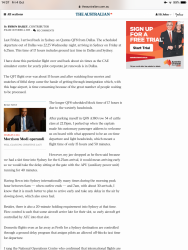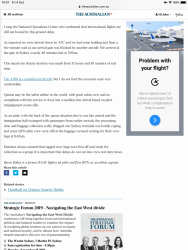I wouldn't go that far jb747, however I cannot see that he has any more to offer or any greater knowledge than many of the rest of us.
When he first appeared, with some new theory about MH370, there was a fair bit of commentary, much negative, on pprune.
Looking at the Radschool records, there was a Bailey on 54 course, but there were quite a few Vampire courses after that.
"I learnt to fly on last RAAF Vampire pilot course. I then followed 2 years flying Sabres and 3 tours on Mirage 111O. Highlight was member of 77 Squadron 1975 Mirage aerobatic display team. After leaving RAAF spent 18 months as Air Traffic Controller whilst flying a Nomad on a commuter service out of Sydney.
Joined Pel Air flying Learjets and Westwinds 5 years,then proceeded overseas to seek airline flying.
Which gets us to about 1980. QF were recruiting then, and pretty much unbroken until 1989.
Back in Australia I flew Mick Doohans private jet and ended up as Chief Pilot Gold Coast with 12 corporate jet types on licence. I resigned due to CASA's attitude to general aviation. Now I fly, as a contract pilot, large private jet internationally on my U.S. licence, and a Learjet with a cadre of former fighter pilots on military exercises."
Why would you quit your job because you didn’t like CASA? No pilot in Oz likes CASA, but we’re generally able to offset that dislike with a liking for pay packets.
As for the article....I’m afraid that he’s touching something that he should leave alone.
Firstly the decision to hold at the gate is the company’s.
If you arrive early, you’re not going to be able to slot in early. That may have happened 10 plus years ago, but unlikely now. At the very least you’ll be held until your slot time, and then you’ll be expected to have whatever holding is in force on top of that. A380s from Dallas do not carry an alternate, unless forced to by weather, and I doubt that they can even then. There is no fuel cost for the flight in holding at the gate, with the APU running, because you can keep the tanker plugged in, and top it back up before you push back.
The flight is extremely fuel limited, so it’s always operated to minimise the fuel burn. Slowing down does not save fuel, especially when you are already operating at the best cost index. He mentions that the flight will be operated into a headwind, but neglects to point out that it’s more fuel efficient to go slightly faster into a headwind (and slow down with a tail wind).
And so what if Emirates had crew luggage off first. The crew are not going to be affected by any delay in getting their luggage, as they are all going home. And many passengers are somewhat peeved when they see crew luggage coming off before that of passengers (rightly or wrongly).
















